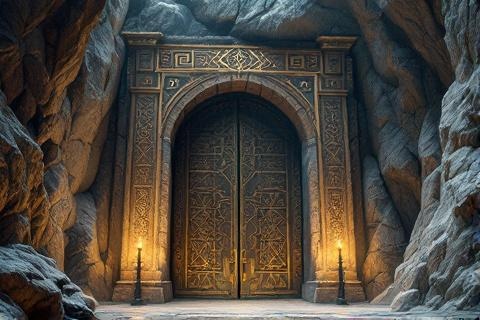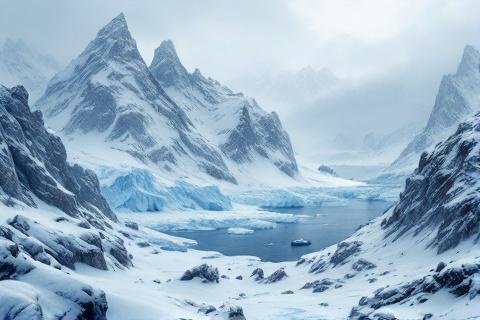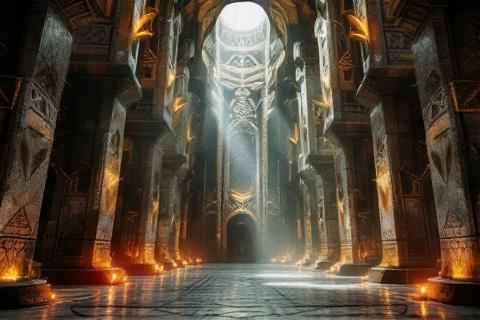
Ered Luin: The Blue Mountains of Middle-earth
Discover the Lost Realms and Dwarven Heritage of the Ered Luin
Geography and Location

The Ered Luin, also known as the Blue Mountains, stands as one of the most
ancient mountain ranges in Middle-earth, forming a
formidable natural boundary along the western edge of Eriador. These mountains
served as the easternmost border of Beleriand during the
First Age, rising majestically from the surrounding landscapes
as a testament to the earliest shaping of Arda.
Before the First Age, these mighty peaks formed an unbroken wall between the
lands of Eriador and Beleriand, playing a crucial role in the geographic
separation of these two vast regions. The mountains stood as silent witnesses to
the earliest days of Middle-earth, when the Valar themselves
shaped the lands and the first Elves made their Great Journey
westward.
The range derives its common name from the distinct blue-grey hue of its stone,
a characteristic that sets it apart from other mountain ranges in Middle-earth.
This unique coloration results from the presence of rare minerals within the
mountain's rock composition, creating a striking appearance that is particularly
notable during sunrise and sunset when the peaks seem to shimmer with a bluish
tint.
The impressive geographical span of the Ered Luin stretches from the frigid Ice
Bay of Forochel in the far north to the Gulf of Lune in the south, covering
hundreds of leagues. This extensive range served as both a barrier and a
landmark for the peoples of Middle-earth, with its northern reaches remaining
largely unexplored due to the harsh climate and treacherous conditions.
Ancient Dwarven Realms

The two greatest Dwarven cities of the Blue Mountains, Nogrod
and Belegost, stood as magnificent testimonies to the architectural and
engineering prowess of the Firebeard and Broadbeam Dwarves. These mighty realms,
established during the First Age, became renowned centers of craftsmanship and
trade, fostering strong relations with the Elves of Beleriand, particularly the
realm of Thingol.
Within the mountain's heart, the Dwarves carved vast halls and chambers that
rivaled the grandeur of Khazad-dûm itself. These caverns
extended deep into the mountain's core, featuring soaring ceilings supported by
intricately carved pillars and walls adorned with geometric patterns that
reflected the Dwarves' mathematical precision and artistic sophistication.
The craftsmen of Nogrod and Belegost achieved legendary status throughout
Middle-earth for their exceptional metalwork and jewelry making. Their skills
were so renowned that they were commissioned to create some of the most famous
treasures of the First Age, including the Nauglamír, the celebrated necklace
that would later hold one of the Silmarils.
Throughout the mountains, the Dwarves established an intricate network of
tunnels and passages connecting their various settlements and mining operations.
This complex system allowed for efficient transportation of goods and materials
between different levels and regions of their realm, while also providing
strategic advantages during times of conflict.
Natural Resources
The Blue Mountains were blessed with abundant deposits of precious metals and
gems, making them one of the richest mineral sources in Middle-earth. The
Dwarven miners discovered veins of gold, silver, and precious stones that
rivaled those found in the greatest mines of their race, contributing
significantly to the wealth and prosperity of their kingdoms.
Iron ore and other valuable metals were found in great quantities throughout the
range, providing essential materials for the forges of Nogrod and Belegost. The
quality of these resources enabled the Dwarven smiths to create weapons and
armor of exceptional durability, including the famous Dragon-helm of Dor-lómin.
The mountains yielded a unique variety of blue marble and stone that became
highly sought after throughout Beleriand and beyond. These materials were prized
not only for their aesthetic appeal but also for their durability, making them
ideal for both decorative and structural applications in the great works of the
First Age.
Along the lower slopes of the Ered Luin grew vast forests of ancient trees,
providing valuable timber resources for construction and fuel. These woodlands
were carefully managed by the Dwarves, who understood the importance of
maintaining a sustainable supply of wood for their forges and building projects.
The Northern Reaches

The northern reaches of the Ered Luin near the Ice Bay of Forochel experience
some of the most severe weather conditions in Middle-earth. These areas are
perpetually gripped by fierce winds and extreme cold, making them virtually
uninhabitable except for the hardiest of beings, including the mysterious
Lossoth who occasionally venture into the mountain's lower slopes.
The highest peaks of the Blue Mountains remain snow-covered throughout the year,
their jagged summits piercing the clouds at heights that rival those of the
Misty Mountains. These elevated regions present treacherous conditions for
travelers, with unexpected snowstorms and treacherous ice fields that have
claimed many unwary wanderers.
The natural geography of the Ered Luin provides numerous defensive advantages,
with steep cliffs and narrow passes that can be easily defended by small groups
against larger forces. These features played a crucial role in the survival of
various settlements throughout the mountain range's history.
While the main passes through the Ered Luin are well-known, numerous lesser-used
paths exist, known only to those who have lived in the mountains for
generations. These hidden routes served as vital escape paths during times of
danger and provided secret ways for trade and communication between isolated
communities.
The Southern Hills

The southern regions of the Ered Luin feature more accessible terrain, with
gradually sloping hillsides that allow for easier travel and settlement. These
areas became increasingly important after the War of
Wrath, when many displaced peoples sought new homes in
the more hospitable parts of the mountain range.
Where the mountains meet the Gulf of Lune, the landscape creates natural harbors
and protected bays that proved invaluable for maritime trade. This region became
particularly significant after the reshaping of Middle-earth, when the great
havens of the Elves were established along the coast.
Nestled within the mountain range are numerous sheltered valleys and dales that
provide ideal conditions for agriculture and settlement. These protected areas
offered refuge to various peoples throughout the ages, from the Dwarves of the
First Age to the settlers of later periods.
The Blue Mountains contained several well-established trade routes that
connected the eastern and western lands, facilitating commerce between different
regions and peoples. These paths became especially important after the drowning
of Beleriand, as they provided crucial links between the surviving realms of
Middle-earth.
Architectural Marvels

The Dwarven architects of the Ered Luin developed a unique architectural style
that seamlessly integrated their constructions with the natural mountain rock.
Their halls and chambers were designed to work with the mountain's natural
features, creating spaces that appeared both organic and carefully crafted.
The mountain cities featured advanced systems for water management and air
circulation, demonstrating the Dwarves' mastery of environmental engineering.
These systems included elaborate networks of channels and shafts that brought
fresh water and air to the deepest levels of their settlements while removing
waste and stale air.
The great halls of Nogrod and Belegost were supported by massive columns carved
from the living rock, often incorporating intricate geometric patterns and runes
that told the history of their people. These supports were not merely functional
but served as works of art that celebrated Dwarven culture and craftsmanship.
Throughout the mountain range, the Dwarves constructed numerous concealed
entrances and passages, many of which were known only to their makers. These
hidden ways were crafted with such skill that they appeared to be natural
features of the mountain, discoverable only by those who knew the secret signs
and mechanisms.
Defense Systems
The main entrances to the Dwarven fortresses were carefully positioned to take
advantage of natural defensive features while allowing for efficient
surveillance of approaching travelers. These locations were chosen to provide
maximum protection while maintaining accessibility for trade and diplomacy.
The Dwarves supplemented the mountains' natural defenses with sophisticated
constructed fortifications, including walls that blended seamlessly with the
surrounding cliffs. These defensive structures were built to withstand both
siege weapons and the natural forces of weather and time.
A complex system of watch-posts and signal points was established along the
mountain range, allowing for rapid communication between different settlements
and strategic locations. These posts were staffed continuously and played a
crucial role in maintaining the security of the mountain kingdoms.
The defensive planning of the Blue Mountains included numerous escape routes and
emergency exits integrated into the mountain architecture. These passages were
designed to allow for swift evacuation in times of danger and were kept secret
from all but the most trusted members of Dwarven society.
